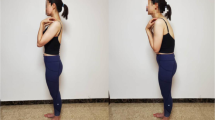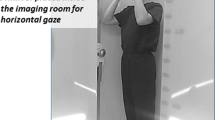Abstract
Purpose
To investigate the age-specific normative values of whole-body sagittal alignment (WBSA) including global balance parameters in healthy adults and to clarify the correlations among parameters based on the data from three international multicenter.
Methods
Three hundred and seventeen healthy subjects (range: 20–84 y.o., mean: 43.8 ± 14.7 y.o.) were included and underwent whole-body biplanar X-ray imaging system. Spinopelvic parameters and knee flexion (KF), the center of acoustic meatus (CAM)-hip axis (HA), and C2 dentiform apophyse (OD)-HA, the cranial center (Cr)-HA were evaluated radiologically. Sub-analysis for correlation analysis between age and parameters and among parameters was performed to investigate age-specific change and compensatory mechanisms.
Results
For age-related change, C2-7 angle (r = .326 for male/.355 for female), KF (r = .427/.429), and SVA (r = .234/.507) increased with age in both male and female group. For global parameters related to the center of the gravity, correlations with age were not significant (r = .120/.161 for OD-HA, r = .163/.275 for Cr-HA, r = .149/.262 for CAM-HA). Knee flexion (KF) has correlation with global parameters (i.e., SVA, OD-HA, Cr-HA, CAM-HA) and does not have correlations with local spinopelvic alignment.
Conclusion
While several local alignment changes with age were found, changes in global parameters related to the center of gravity were kept relatively mild by the chain of compensation mechanisms including the lower limbs. We showed the normative values for a comprehensive WBSA in standing posture from large international healthy subjects’ database.

Similar content being viewed by others

References
Hasegawa K, Okamoto M, Hatsushikano S, Shimoda H, Ono M, Watanabe K (2016) Normative values of spino-pelvic sagittal alignment, balance, age, and health-related quality of life in a cohort of healthy adult subjects. Eur Spine J 25:3675–3686. https://doi.org/10.1007/s00586-016-4702-2
Protopsaltis T, Schwab F, Bronsard N, Smith JS, Klineberg E, Mundis G, Ryan DJ, Hostin R, Hart R, Burton D (2014) The T1 pelvic angle, a novel radiographic measure of global sagittal deformity, accounts for both spinal inclination and pelvic tilt and correlates with health-related quality of life. JBJS 96:1631–1640
Kim YC, Lenke LG, Lee SJ, Gum JL, Wilartratsami S, Blanke KM (2017) The cranial sagittal vertical axis (CrSVA) is a better radiographic measure to predict clinical outcomes in adult spinal deformity surgery than the C7 SVA: a monocentric study. Eur Spine J 26:2167–2175. https://doi.org/10.1007/s00586-016-4757-0
Le Huec JC, Faundez A, Dominguez D, Hoffmeyer P, Aunoble S (2015) Evidence showing the relationship between sagittal balance and clinical outcomes in surgical treatment of degenerative spinal diseases: a literature review. Int Orthop 39:87–95. https://doi.org/10.1007/s00264-014-2516-6
Hasegawa K, Okamoto M, Hatsushikano S, Watanabe K, Ohashi M, Vital J-M, Dubousset J (2020) Compensation for standing posture by whole-body sagittal alignment in relation to health-related quality of life. Bone Joint J 102:1359–1367
Harroud A, Labelle H, Joncas J, Mac-Thiong JM (2013) Global sagittal alignment and health-related quality of life in lumbosacral spondylolisthesis. Eur Spine J 22:849–856. https://doi.org/10.1007/s00586-012-2591-6
Schwab F, Lafage V, Patel A, Farcy J-P (2009) Sagittal plane considerations and the pelvis in the adult patient. Spine 34:1828–1833
Takemoto M, Boissiere L, Novoa F, Vital JM, Pellise F, Perez-Grueso FJ, Kleinstuck F, Acaroglu ER, Alanay A, Obeid I, Obeid I (2016) Sagittal malalignment has a significant association with postoperative leg pain in adult spinal deformity patients. Eur Spine J 25:2442–2451. https://doi.org/10.1007/s00586-016-4616-z
Amabile C, Le Huec JC, Skalli W (2018) Invariance of head-pelvis alignment and compensatory mechanisms for asymptomatic adults older than 49 years. Eur Spine J 27:458–466. https://doi.org/10.1007/s00586-016-4830-8
Hasegawa K, Okamoto M, Hatsushikano S, Shimoda H, Ono M, Homma T, Watanabe K (2017) Standing sagittal alignment of the whole axial skeleton with reference to the gravity line in humans. J Anat 230:619–630. https://doi.org/10.1111/joa.12586
Obeid I, Hauger O, Aunoble S, Bourghli A, Pellet N, Vital J-M (2011) Global analysis of sagittal spinal alignment in major deformities: correlation between lack of lumbar lordosis and flexion of the knee. Eur Spine J 20:681
Jalai CM, Cruz DL, Diebo BG, Poorman G, Lafage R, Bess S, Ramchandran S, Day LM, Vira S, Liabaud B, Henry JK, Schwab FJ, Lafage V, Passias PG (2017) Full-body analysis of age-adjusted alignment in adult spinal deformity patients and lower-limb compensation. Spine 42:653–661. https://doi.org/10.1097/BRS.0000000000001863
Yukawa Y, Kato F, Suda K, Yamagata M, Ueta T, Yoshida M (2018) Normative data for parameters of sagittal spinal alignment in healthy subjects: an analysis of gender specific differences and changes with aging in 626 asymptomatic individuals. Eur Spine J 27:426–432. https://doi.org/10.1007/s00586-016-4807-7
Barrey C, Roussouly P, Perrin G, Le Huec JC (2011) Sagittal balance disorders in severe degenerative spine: can we identify the compensatory mechanisms? Eur Spine J 20(Suppl 5):626–633. https://doi.org/10.1007/s00586-011-1930-3
Lazennec JY, Folinais D, Bendaya S, Rousseau MA, Pour AE (2016) The global alignment in patients with lumbar spinal stenosis: our experience using the EOS full-body images. Eur J Orthop Surg Traumatol Orthop Traumatol 26:713–724. https://doi.org/10.1007/s00590-016-1833-4
Le Huec JC, Hasegawa K (2016) Normative values for the spine shape parameters using 3D standing analysis from a database of 268 asymptomatic Caucasian and Japanese subjects. Eur Spine J 25:3630–3637. https://doi.org/10.1007/s00586-016-4485-5
Iyer S, Lenke LG, Nemani VM, Albert TJ, Sides BA, Metz LN, Cunningham ME, Kim HJ (2016) Variations in sagittal alignment parameters based on age: a prospective study of asymptomatic volunteers using full-body radiographs. Spine 41:1826–1836
Fairbank JC, Pynsent PB (2000) The Oswestry disability index. Spine 25:2940–2953
Duval-Beaupere G, Schmidt C, Cosson P (1992) A Barycentremetric study of the sagittal shape of spine and pelvis: the conditions required for an economic standing position. Ann Biomed Eng 20:451–462
Tardieu C, Hasegawa K, Haeusler M (2017) How did the pelvis and vertebral column become a functional unit during the transition from occasional to permanent bipedalism? Anatom Record 300:912–931. https://doi.org/10.1002/ar.23577
Le Huec JC, Saddiki R, Franke J, Rigal J, Aunoble S (2011) Equilibrium of the human body and the gravity line: the basics. Eur Spine J 20(Suppl 5):558–563. https://doi.org/10.1007/s00586-011-1939-7
Glassman SD, Berven S, Bridwell K, Horton W, Dimar JR (2005) Correlation of radiographic parameters and clinical symptoms in adult scoliosis. Spine 30:682–688
Glaser DA, Doan J, Newton PO (2012) Comparison of 3-dimensional spinal reconstruction accuracy: biplanar radiographs with EOS versus computed tomography. Spine 37:1391–1397. https://doi.org/10.1097/BRS.0b013e3182518a15
Amabile C, Pillet H, Lafage V, Barrey C, Vital JM, Skalli W (2016) A new quasi-invariant parameter characterizing the postural alignment of young asymptomatic adults. Eur Spine J 25:3666–3674. https://doi.org/10.1007/s00586-016-4552-y
Le Huec J, Demezon H, Aunoble S (2015) Sagittal parameters of global cervical balance using EOS imaging: normative values from a prospective cohort of asymptomatic volunteers. Eur Spine J 24:63–71
Yoshida G, Alzakri A, Pointillart V, Boissiere L, Obeid I, Matsuyama Y, Vital JM, Gille O (2017) Global spinal alignment in patients with cervical spondylotic myelopathy. Spine. https://doi.org/10.1097/BRS.0000000000002253
Vialle R, Levassor N, Rillardon L, Templier A, Skalli W, Guigui P (2005) Radiographic analysis of the sagittal alignment and balance of the spine in asymptomatic subjects. JBJS 87:260–267. https://doi.org/10.2106/jbjs.D.02043
Garagiola DM, Tarver RD, Gibson L, Rogers RE, Wass JL (1989) Anatomic changes in the pelvis after uncomplicated vaginal delivery: a CT study on 14 women. Am J Roentgenol 153:1239–1241
Roussouly P, Gollogly S, Berthonnaud E, Dimnet J (2005) Classification of the normal variation in the sagittal alignment of the human lumbar spine and pelvis in the standing position. Spine 30:346–353. https://doi.org/10.1097/01.brs.0000152379.54463.65
Ferrero E, Liabaud B, Challier V, Lafage R, Diebo BG, Vira S, Liu S, Vital JM, Ilharreborde B, Protopsaltis TS, Errico TJ, Schwab FJ, Lafage V (2016) Role of pelvic translation and lower-extremity compensation to maintain gravity line position in spinal deformity. J Neurosurg Spine 24:436–446. https://doi.org/10.3171/2015.5.SPINE14989
Acknowledgements
No funds were received in support of this work. No benefits in any form have been or will be received from a commercial party related directly or indirectly to the subject of this manuscript, either personally or institutionally.
Author information
Authors and Affiliations
Corresponding author
Ethics declarations
Conflict of interest
The author's declare that they have no conflict of interest.
Additional information
Publisher's Note
Springer Nature remains neutral with regard to jurisdictional claims in published maps and institutional affiliations.
Rights and permissions
Springer Nature or its licensor (e.g. a society or other partner) holds exclusive rights to this article under a publishing agreement with the author(s) or other rightsholder(s); author self-archiving of the accepted manuscript version of this article is solely governed by the terms of such publishing agreement and applicable law.
About this article
Cite this article
Ouchida, J., Nakashima, H., Kanemura, T. et al. The age-specific normative values of standing whole-body sagittal alignment parameters in healthy adults: based on international multicenter data. Eur Spine J 32, 562–570 (2023). https://doi.org/10.1007/s00586-022-07445-y
Received:
Revised:
Accepted:
Published:
Issue Date:
DOI: https://doi.org/10.1007/s00586-022-07445-y



